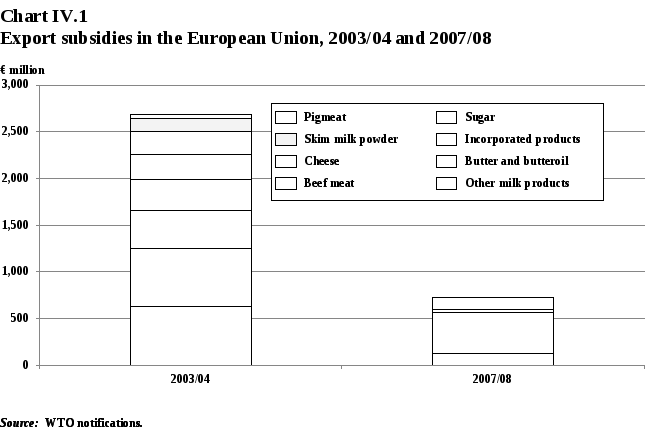
- •Developments in selected sectors
- •Agriculture
- •Agriculture in the European Union
- •Imports of selected agricultural products, 2006-09
- •Agriculture policies
- •Domestic support Direct payments
- •Internal Market supports
- •Rural development
- •Market access
- •Tariffs
- •Tariff quotas
- •Special Agricultural Safeguard
- •Export subsidies
- •Domestic support levels
- •Trade in Services
- •Introduction
- •Financial services
- •Banking
- •Insurance
- •Response to the global financial crisis
- •Transport
- •(A) Road transport
- •(B) Rail transport
- •(C) Maritime transport
- •Telecommunications and postal services (a) Telecommunications
- •References
Tariff quotas
-
The EU notified 114 separate tariff quotas as being in operation in the calendar year 2009 and marketing year 2008/09.23 These included several cases where two or more quotas covered the same or similar products, for example there are eight tariff quotas for rice covering paddy rice, broken rice, husked rice, and milled rice, including three separate quotas for semi-milled and wholly milled rice. This is further complicated by the changing number, product coverage, and quantities of different tariff quotas applied by the EU as it took account of the WTO commitments of acceding countries. In addition, some quotas are so small it is hard to consider them as commercially meaningful, such as quotas for 1,300 tonnes of millet, 4,504 tonnes of chemically pure fructose, or 7 tonnes of rice. The Commission noted that changes to quotas were the result of EU enlargements and subsequent GATT Article XXVIII negotiations, and stated that tariff quotas are market access openings and an assessment of them should take this into account.
-
The methods used to administer and allocate tariff quotas vary widely; some are allocated to supplying countries while others are open to all potential suppliers; the validity of licences to import inside a quota vary from a few weeks to one year; and quotas are administered in different ways from licences on demand, to historical importers, to first-come-first-served.24
-
Fill rates vary widely from one tariff quota to another. In the last notification for marketing year 2008/09 and calendar year 2009, 39 tariff quotas were completely used while 20 had no imports at all.
Special Agricultural Safeguard
-
In its Uruguay Round commitments, the EU reserved the right to use the Special Agricultural Safeguard (SSG) on 539 tariff lines. However, actual use of the SSG has been on a limited range of products. The price-based SSG has been made operational for chicken, turkey, and sugar products almost continuously, with some egg products added for marketing years 2007/08 and 2008/09. The EU has calculated trigger volumes for fruit and vegetables on a regular basis but the volume-based SSG has never been implemented.
-
Export subsidies
-
The export subsidy regime in the EU has not changed substantially over the past few years. Under its WTO commitments, the EU can use export subsidies for 20 different product groups, of which 10 actually received subsidies in the 2007/08 marketing year, the most recent year for which a notification has been made.25 The amount of export subsidy varies from one product to another and can vary from one market to another but, in response to domestic reforms and higher world prices for agricultural products, some products no longer receive export subsidies.
-
As at February 2011, export subsidies continue to be available for cereals, beef and veal, poultry meat, pig meat, eggs, sugar, and some processed goods but they have not been used on cereals since July 2006 or on sugar since October 2008. In marketing year 2007/08, sugar products received most export subsidies in terms of both the quantity of subsidized exports and the value of the subsidies, followed by pig meat, and in terms of the quantity of subsidized exports, wine (Chart IV.1). In January 2009, in response to low world prices, export subsidies were reintroduced for dairy products in response to low world prices but were removed in October of the same year.26 The application of export subsidies can exacerbate swings in world prices and change the terms of trade to the detriment of other exporters. However, the Commission noted that budget spending on export subsidies has fallen to less than one-tenth the level of the early 1990s. They also stated that there is no correlation between the use of export subsidies by the EU and its share in the world market, and that the reintroduction of export subsidies in 2009 for dairy products did not fully bridge the gap between EU and prevailing world market prices at that time.
-

